电影历史英文版
英文版电影介绍:海上钢琴师
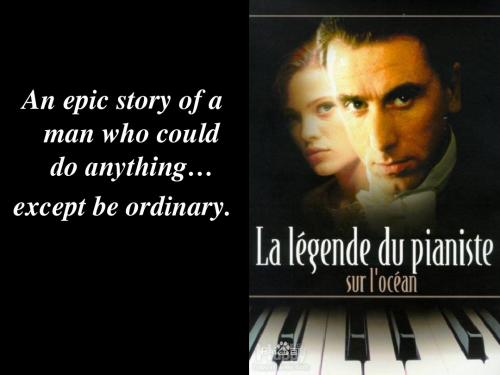
• After the war ends ,the ship is forced to be destroyed and exploded. Fame, fortune and woman can’t make him tread on land. 1900 chooses to die on the ship rather than getting off. The marvelous life of 1900 makes him become the legend.
• 1900 is very unhappy and breaks the record. Again, he just keeps his mouth shut and never shares with the others. It is obvious that he no longer wants to share; he is too tired to find opportunities to air his feeling.
精彩对白
• 1900: you smoke it, I don’t know how. 你抽吧,我不会。
•
1900: I was born on this ship, and the world passed me by, but two thousand people at a time. And there were wishes here, but never more than fit between prow and stern. You played out your happiness but on a piano that was not infinite. I learned to live that way. Land? Land is a ship too big for me, it's a woman too beautiful, it's a voyage too long, perfume too strong. It's music I don't know how to make. I can never get off this ship. At best, I can step off my life. After all, I don't exist for anyone. You're exception, Max. You're the only one who knows I'm here. You're a minority, and you'd better get used to it. Forgive me, my friend, but I'm not getting off.
外国电影发展史英文版

Their first film, Sortie de l'usine Lumière de Lyon, shot in 1894, is considered the first real motion picture in history.
Persistence of vision(0.1s~~0.4s)
公认的世界上第一幅照片是法国人尼埃普斯于1827年拍摄出来的,但是现在全世界公认的摄 影术的发明者却是法国的达盖尔。Louis-Jacques-Mandé Daguerre
Eadweard J. Muybridg (/ˌ ɛdwərd ˌma ɪbrɪdʒ/) was an English photographer important for his pioneering work in photographic studies of motion, and early work in motion-picture projection.
?公认的世界上第一幅照片是法国人尼埃普斯于1827年拍摄出来的但是现在全世界公认的摄影术的发明者却是法国的达盖尔
The
History
of Western Movies
Movie is called :
Louis and Auguste Lumiere (France)
——the father of movies
Charles-Émile Reynaud was a French pioneer, responsible for the first projected animated cartoon films. Reynaud created the Praxinoscope in 1877 and the Théâtre Optique in December 1888, and on 28 October 1892 he projected the first animated film in public, Pauvre Pierrot, in Paris
必看的100部经典英文电影
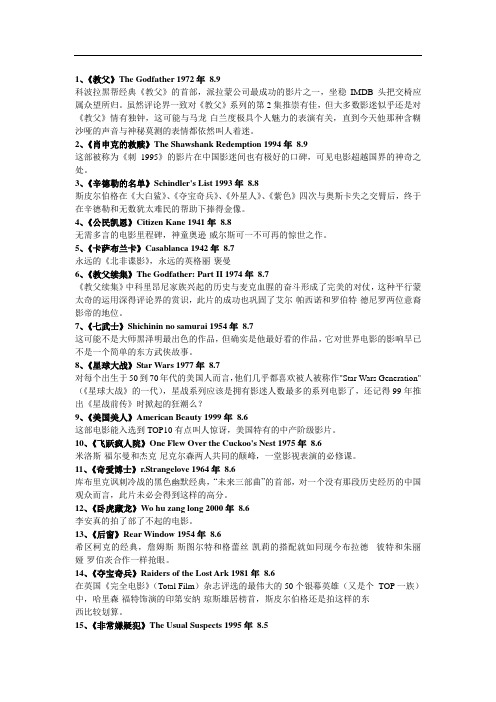
1、《教父》The Godfather 1972年8.9科波拉黑帮经典《教父》的首部,派拉蒙公司最成功的影片之一,坐稳IMDB头把交椅应属众望所归。
虽然评论界一致对《教父》系列的第2集推崇有佳,但大多数影迷似乎还是对《教父》情有独钟,这可能与马龙·白兰度极具个人魅力的表演有关,直到今天他那种含糊沙哑的声音与神秘莫测的表情都依然叫人着迷。
2、《肖申克的救赎》The Shawshank Redemption 1994年8.9这部被称为《刺1995》的影片在中国影迷间也有极好的口碑,可见电影超越国界的神奇之处。
3、《辛德勒的名单》Schindler's List 1993年8.8斯皮尔伯格在《大白鲨》、《夺宝奇兵》、《外星人》、《紫色》四次与奥斯卡失之交臂后,终于在辛德勒和无数犹太难民的帮助下捧得金像。
4、《公民凯恩》Citizen Kane 1941年8.8无需多言的电影里程碑,神童奥逊·威尔斯可一不可再的惊世之作。
5、《卡萨布兰卡》Casablanca 1942年8.7永远的《北非谍影》,永远的英格丽·褒曼6、《教父续集》The Godfather: Part II 1974年8.7《教父续集》中科里昂尼家族兴起的历史与麦克血腥的奋斗形成了完美的对仗,这种平行蒙太奇的运用深得评论界的赏识,此片的成功也巩固了艾尔·帕西诺和罗伯特·德尼罗两位意裔影帝的地位。
7、《七武士》Shichinin no samurai 1954年8.7这可能不是大师黑泽明最出色的作品,但确实是他最好看的作品,它对世界电影的影响早已不是一个简单的东方武侠故事。
8、《星球大战》Star Wars 1977年8.7对每个出生于50到70年代的美国人而言,他们几乎都喜欢被人被称作"Star Wars Generation"(《星球大战》的一代),星战系列应该是拥有影迷人数最多的系列电影了,还记得99年推出《星战前传》时掀起的狂潮么?9、《美国美人》American Beauty 1999年8.6这部电影能入选到TOP10有点叫人惊讶,美国特有的中产阶级影片。
好莱坞电影简史(英文版)
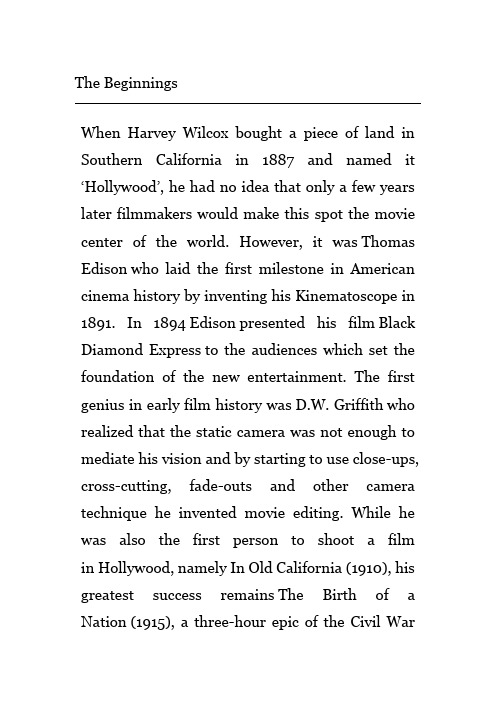
The BeginningsWhen Harvey Wilcox bought a piece of land in Southern California in 1887 and named it ‘Hollywood’, he had no idea that only a few years later filmmakers would make this spot the movie center of the world. However, it was Thomas Edison who laid the first milestone in American cinema history by inventing his Kinematoscope in 1891. In 1894 Edison presented his film Black Diamond Express to the audiences which set the foundation of the new entertainment. The first genius in early film history was D.W. Griffith who realized that the static camera was not enough to mediate his vision and by starting to use close-ups, cross-cutting, fade-outs and other camera technique he invented movie editing. While he was also the first person to shoot a film in Hollywood, namely In Old California (1910), his greatest success remains The Birth of a Nation (1915), a three-hour epic of the Civil Warand its aftermath. The movie remains controversial: movie historians acknowledge its pioneering approach to visual storytelling as well as its technical achievements, but criticize the explicit racist depiction of blacks and the glorification of the Ku Klux Klan.Among the earliest movie stars we find the impersonation of innocence or ‘America’s Sweetheart,’ Mary Pickford, also Gloria Swanson, and Douglas Fairbanks, whose most popular films were The Mask of Zorro (1920) and Robin Hood (1922). In the 1920s more and more people went to the nickelodeons (the early movie theaters where the admission fee was a nickel) to watch such epics as, for example, Cecil B. DeMille’s The Ten Commandments (1923).The mild climate and the year-round sunshine drew more and more filmmakers to Southern California, where the center of American film industry gradually emerged. SamuelGoldwyn, Louis B. Mayer, the Hungarian-born Adolph Zukor and William Fox, and the four Warner brothers dominated the production side of the business and established their own movie studios. The studio system was to rule the film market in the following three decades. The five major studios, or the Big Five as they were called at the time, were Warner Bros., 20th CenturyFox, Metro-Goldwyn-Mayer, Paramount,and RKO, while among the then smaller studios we count Columbia, Universal, and United Artists. In the 1920s a new genre, the slapstick comedy started to gain ground in film production with such names as Fatty Arbuckle or British-born Charlie Chaplin who eventually became his own star, director, and producer. He developed the character of the Tramp, a comic but also pathetic figure in overlarge gentle man’s clothes, bowler hat and grotesquely big shoes, and made several movies in this role: TheKid (1921), The Gold Rush (1925), etc. Chaplin kept making basically silent movies in the sound era as well, e.g. Modern Times (1936), but his talkie The Great Dictator (1940) with its caricature of Adolf Hitler was also a popular success. Chaplin’s greatest rival was the stony-faced Buster Keaton who always played the perfect scapegoat and was famous for never smiling on screen. His best film is considered to be Steamboat Bill (1928).Besides slapstick comedies, the major genres were swashbucklers, historical films and melodramas, although filmmakers were experimenting with all kinds of genres throughout the decade.The premiere of The Jazz Singer in 1927 launched a new technological breakthrough, the talking picture, or talkie, with the result that the silent film had practically disappeared by the 1930s. The careers of many actors were broken as they couldnot live up to the demands of this new way of moviemaking. Among those who survived we find Greta Garbo, Joan Crawford, or Gloria Swanson. Also in 1927, the Academy of Motion Picture Arts and Sciences (AMPAS) was founded and the first Academy Awards (popularly known as Oscars, after the nickname of the statuette given to the winners) were presented in February 1929.The Golden Age of American Cinema: the 1930s to the 1940sThe 1930sWith the appearance of the ‘talkie’ a new era of filmmaking began in Hollywood. The most popular genres of the time were the western, slapstick comedy, musical, animated cartoon, biopic (biographical picture), etc.As opposed to today’s practice producers, directors, actors, technicians, etc. were kept on salaries at the different studios, each studio having its own personnel. The studios also owned hundreds of theaters in cities and towns where they were able to show their own films. Big business went hand in hand with infamous relationships and scandals, and by the beginning of the 1930s Hollywood came to be known as the most sinful city. As a countermeasure General Will Hays introduced the Production Code (not enforced until 1934) to set the guidelines for films concerning sex, violence, and religion.In the 1930s also new genres appeared such as the adventure or fantasy movies. This was the time of Johnny Weissmuller’s first film, Tarzan the Ape Man (1932), which was followed by Tarzan and His Mate (1934) and several others. David O. Selznick, one of the most famous producers of the period, introduced the first classic monster in movie history, King Kong, in 1933. Another greatadventure hit came when Charles Laughton came to Hollywood after the success of The Private Life of Henry VIII (1933) and played in the Mutiny on the Bounty (1935).Another new development of the decade was the horror film. In 1931 the Hungarian Bela Lugosi appeared as a vampire in Dracula and Boris Karloff as the monster in Frankenstein, laying the foundation of a long tradition. The 1930s also saw the unfolding of the gangster movie genre with Howard Hawks’ Scarface (1932), and the Hungarian-born director Michael Curtiz’s Angels With Dirty Faces (1938).New movie comedians also surfaced beside Chaplin: such figures appeared as the group named the Three Stooges in Woman Haters (1934), and they went on producing slapstick comedies until 1959. The best film of thepopular pair of comedians Laurel and Hardy, Sons of the Desert, also came out in 1933. After World War I numerous European artists came to Hollywood: Ernst Lubitsch, Alfred Hitchcock, Fritz Lang and Josef von Sternberg among the directors as well as for example Marlene Dietrich among the actors. Dietrich and von Sternberg made seven films together in Hollywood out of which Morocco (1930) and Shanghai Express (1932) are the most memorable.The greatest year in the 1930s was probably 1939 when such movies appeared as The Wizard of Oz, Gone With the Wind (winning eight Oscars that year with British actress Vivien Leigh and Clark Gable in the leading roles), Stagecoach (directed by John Ford, one of the finest directors of the time), or Mr. Smith Goes to Washington. The 1930s also marked the beginning of the famous feature-length animationfilm production of the Disney Company with the classic Snow White and the Seven Dwarfs (1937). Other famous cartoons of the company were soon to follow: Cinderella (1950), Sleeping Beauty (1959), and One Hundred and One Dalmatians (1961).This was also the decade when the first great stars as we know them appeared: Clark Gable, Vivien Leigh, Katharine Hepburn, Bette Davis, just to name a few, while others, for example Fred Astaire and Ginger Rogers were best known for their dancing talents.1940s and the Film noirAs noted above, Alfred Hitchcock came to Hollywood to direct his first American film, Rebecca (1940) under David O. Selznick. Among his later thrillers that became classics of American film history, Notorious (1946), RearWindow (1954), Vertigo (1958), North by Northwest (1959), Psycho (1960), and The Birds (1963) are considered the best by critics and fans.1941, the year in which the US entered World War II, meant shortages, blackouts, and other wartime restrictions which harshly affected the film industry. Yet, by 1946 the attendance in theaters reached the highest percentage up to that point. Many directors and producers (John Ford, William Wyler and Frank Capra among them) set out to make documentaries and training films to aid the war. The most famous, partly propaganda film of the time was Michael Curtiz’s Casablanca (1942) starring Humphrey Bogart, Ingrid Bergman, and Peter Lorre. This dark romantic story illustrates the struggles of Rick Blain, a bar keeper in Casablanca who has the means to save his former lover’s husband by giving him false documents, while this way he would lose the woman he loves. Anothersuccessful film with patriotic flair was Mrs. Miniver (1942) by William Wyler about the citizens of a British village struggling to survive the war. In 1941 the twenty-three-year-old Orson Welles made his début in his own masterpiece Citizen Kane. The film shows the life of Charles Foster Kane, who begins to fight for power within the publishing industry and turns out to be a ruthless tyrant whose actions ruin all around him. The story is mediated through a reporter whose job is to find out what Kane’s last word, ‘rosebud’ could have meant. The movie was allegedly based on the life of the contemporary newspaper magnate, William Randolph Hearst, w ho tried to hinder the film’s appearance by all means. The film, nonetheless, became one of the greatest classics of American film history. Welles’ Macbeth (1948) was less successful and after its release the director left for Europe where he starred in Carol Reed’s film noir, The Third Man (1949).Film noir as a genre had its bloom in the 1940s. It expressed the dark and skeptical mood of the general public through its dark black-and-white pictures where lights and shadows stand in great contrast to each other, and disillusioned or corrupt characters. The first film noir to appear in the US was The Maltese Falcon (1941) which brought a turning point in Humphrey Bogart’s career. Other films followed, such as Mildred Pierce (1945), The Big Sleep (1946), or The Postman Always Rings Twice (1946) and the genre lived on all the way into the 1960s.In the 1940s, John Ford started to produce his most famous war movies and westerns (e.g. Fort Apache (1948), Rio Grande (1950)), besides the movie adaptation of such literary classics as The Grapes of Wrath (1940).In the late 1940s, early 1950s a paranoid fear of Communism developed in Hollywood when producers, directors and actors were expected totestify on Communist activities within the industry. Many artists were accused and put on the blacklist (the existence of which has always been denied officially) and banned from working in Hollywood. The career of many stars was broken or endangered, among them Orson Welles, Gregory Peck, Katharine Hepburn, Joseph Losey, Frank Sinatra, or Charlie Chaplin, just to name the most well-known.The end of the 40s also brought the end of the studio system, which was marked by the federal antitrust action separating the production of films from their exhibition. This meant that the studios had to give up their theater networks and had to depend solely on production.The 1950sIn the 1950s television became cinema’s greatest rival. In order to keep their audiences, studiosstarted to produce big-scale spectacular widescreen films that could only be shown in movie theaters. At the same time, as the novelty of television declined, audiences realized that it was the cinema that provided the sort of quality entertainment they were looking for, and the number of viewers began to rise again. Also, the 1950s and 60s marked the end of the Production Code thus more challenging topics, such as sexuality and violence, were also allowed to be filmed.Ever since the 1950s American films are divided more and more into two categories: blockbusters and independent films. Studios tend to make expensive, star oriented, spectacular films whereas independent filmmakers are regarded to be more innovative and quality driven, as they do not depend on the studios’ money.In the decade of the 1950s, new, rebellious heroes emerged: James Dean, Paul Newman, and MarlonBrando along with their female colleagues Kim Novak and Marilyn Monroe. Brando’s first famous appearance was in A Streetcar Named Desire (1951) for which he also received an Oscar nomination. Dean played his most remembered role in Rebel Without a Cause (1955). Monroe became one of the most enduring sex symbols of the century with the help of such performances as in Gentlemen Prefer Blondes (1953) or Some Like it Hot (1959).The age of rock and roll created a new kind of music film, starting with Rock Around the Clock (1956). Elvis Presley’s first appearance in a film came in 1956 with Love Me Tender, and continued with Jailhouse Rock (1957) and other films all the way into the late 60s. Among the most successful musicals of the decade we find An American in Paris (1951), Singin’ in the Rain (1952, depicting the difficulties silent film actors had to face when talkies came to be popular) with Gene Kelly in the leading role, The King and I (1956)and Porgy and Bess (1959). Besides musicals, spectacular epics also had a bloom in the 50s beginning with The Robe (1953), The Ten Commandments (1956), Ben Hur (1959) starring Charlton Heston and winning eleven Oscars out of twelve nominations, and Spartacus (1960) with Kirk Douglas in the leading role.The 1950s also saw the adaptation of the major contemporary dramas, such as Tennessee Williams’ The Glass Managerie (1950), A Streetcar Named Desire (1951) and Cat on a Hot Tin Roof (1958), or Arthur Miller’s Death of a Salesman (1951).1960sTo continue the epic tradition of the 1950s, 20th Century Fox decided to make Cleopatra in 1963, with Elizabeth Taylor as Cleopatraand Richard Burton as Marc Antony. While the epic turned out to be a flop, the musical and comedy genres proved to be more successful among the audiences by this time. One of the greatest and sweetest actresses in these genres was Audrey Hepburn who won the Best Actress Award for Roman Holiday (1953) in which Gregory Peck acted as her well-suited partner. Her career was also notable in the 1960s when she shot Breakfast at Tiffany’s (1961) and the musical My Fair Lady (1964) with Rex Harrison at her side. Other notable music films of the decade were the adaptation of Doctor Dolittle (1967) also with Harrison, the partly animated Disney classic, Mary Poppins (1964) and the by now classic The Sound of Music in 1965 both starring Julie Andrews, and West Side Story (1961), a modern version of Romeo and Juliet in a contemporary New York setting.It was in the 1960s that Stanley Kubrick established his position as one of themost famous auteurs of the century. If his war drama Paths of Glory (1957) was considered controversial, then his films Lolita (1962), the scandalous story of an adult man’s ped ophile passion for an underage girl, or Dr. Strangelove (1964), a dark satire about the outbreak of the nuclear Third World War, aroused even more heated criticism but also a lot of critical acclaim. His greatest masterpiece is considered to be 2001: A Space Odyssey (1968) which is widely hailed as the greatest science-fiction film ever made. In the late 1960s Kubrick moved to England and worked there most of the time until his death in 1999.One of the decade’s masterpieces was Arthur Penn’s Bonnie and Clyde (1967) which already showed the weakening of the Production Code: despite its graphic violence and sympathetic gangsters the film was not banned. Similarly Dustin Hoffman’s first film The Graduate (1967), depicting an ambiguous sexualrelationship between a young man and an older married woman as well as rebellion against boring suburban life, turned out to be a popular success. The code was further undermined in the 1970s. War movies were also popular in the decade and films like Judgment at Nuremberg (1961), The Longest Day (1962) and The Dirty Dozen (1967), an impossible mission in World War II with John Cassavetes, Telly Savalas, Donald Sutherland and Charles Bronson in the leading roles, ran with enormous success.1970sThe period between 1967 and roughly 1980, is called New Hollywood or post-classical Hollywood, which was marked by the appearance of a new group of filmmakers, such as Francis Ford Coppola, Steven Spielberg, George Lucas, and Martin Scorsese, also called the ‘movie brats’.This was the time when several new, bold, innovative but also successful films were made by the young generation. Co ppola’s The Godfather (1972) about the Corleone gangster family ruling in Brooklyn was a milestone in film history, providing numerous memorable quotes and scenes with Marlon Brando as the Don. The film was followed by The Godfather, Part II in 1974 (both the first part and its sequel received an Oscar for Best Picture). At the end of the decade Coppola directed one of the most powerful Vietnam War movies based on the loose adaptation of Joseph Conrad’s Heart of Darkness under the title Apocalypse Now (1979). Two of the most influential horror-thrillers of the decade are William Friedkin’s The Exorcist (1973), and Spielberg’s Jaws (1975). George Lucas’ Star Wars (1977), a science fantasy combining elements of science fiction stories with traditional fairy-tale motifs, has become one of the biggest box-office successes of all time, and created a newstandard for the industry by its high-quality convincing special effects. Star Wars later developed into a trilogy with the release of The Empire Strikes Back (1980) and The Return of the Jedi (1983). Three more prequels –the so-called Episodes I, II and III –were added between 1999–2005. Lucas went on to produce other blockbusters such as Spielberg’s Indiana Jones series beginning with Raiders of the Lost Ark in 1981.Scorsese’s Taxi Driver (1976) was the decade’s most shocking film with its new extremes of violence, showing how a cab driver (Robert DeNiro) tries to save a 13-year-old hooker (Jodie Foster) after not being able to find success with ‘normal’ women. The film’s realism and graphic violence, its depiction of child prostitution and the underworld was without precedent.Besides new directors also a new type of actors established themselves in the era, forexample Jack Nicholson, Robert DeNiro, or Dennis Hopper. Also during this decade the VHS video market developed, creating a new boom in movie making as many films were now produced that were not intended for the big screen but already for the new medium.Woody Allen emerged in the 1970s as an original comic genius who usually wrote, directed and played in his own movies. His directorial début came in 1969 with his film Take the Money and Run and continued with the success of Play it Again Sam (1972) and Sleeper (1973). His major breakthrough came with Annie Hall (1977), a partly biographical love comedy, which won four Oscars in 1978, including Best Picture, Best Director, and Best Actress in a Leading Role for Diane Keaton. Allen has continued to produce a seemingly endless series of films ever since, and although few of them became major box office hits –exceptions are Manhattan (1979), The Purple Rose of Cairo (1985) and Hannah and HerSisters (1986) – he developed an international cult following, particularly in Europe, where his ironic, intellectual, self-doubting brand of humor is more strongly appreciated. The other outstanding comedy series of the era was the Pink Panther series with brilliant British comedian Peter Sellers as bumbling French Inspector Clouseau. The first movie was The Pink Panther (1963) followed by three sequels in the 1970s until the death of Sellers.Just like each decade, the 1970s also had its successful musical films, but light-hearted traditional musicals gave way to more dramatic and darker stories like the persecution of Eastern European Jews in Fiddler on the Roof (1971) or the rise of Nazism in Germany of the 1920s in Cabaret (1972). The music of these films was also changing, showing an increasing influence of contemporary rock and pop in Jesus Christ Superstar (1973), The Rocky Horror Picture Show (1975), Grease (1978), and Hair (1979). Thehorror and adventure genres also continued with British director Ridley Scott’s Alien (1979, followed by sequels in 1986, 1992, and 1997) and the beginning of the Superman sequence (1978, 1980, 1983).1980sIn the 1980s it is difficult to discover any new trends in the film industry as filmmakers tended to depend on the success plan developed in the previous decade, making spectacular disaster epics, action and adventure stories, or buddy movies. This was also the time of MTV that created a new generation of moviegoers. The first producer to exploit this trend was Don Simpson who made Flashdance in 1983. The film tells the story of Alexandra Owen (Jennifer Beals) who works at a construction site during the day and dances at a bar at night, but she really dreams of being a ballet dancer. Flashdance was not the onlymovie about women transforming on the dance floor, as the audience could also witness Baby in Dirty Dancing (1987) turning into a ballroom dancer by the help of Johnny (Patrick Swayze) against the will of her parents.Simpson also started a new kind of film genre, the buddy movies, by releasing Beverly Hills Cop in 1984. The film starred Eddie Murphy whose other buddy action comedies, 48 Hrs. (1982) and Another 48 Hrs. (1990) were also great favorites of the time. Lethal Weapon (1987), the first of a 4-part sequence about a bold and sometimes suicidal widower police officer (Mel Gibson) and his aging partner (Danny Glover) also became one of the most popular action comedies of the 80s and 90s. Although in the Die Hard sequel(1988-1995) we only find one, lonesome hero, a New York police detective (Bruce Willis) who saves the citizens of Los Angeles, Washington, and New York, this series is also considered a buddy movie.Beside action comedies, many significant Vietnam war movies were also released. Among them we find the first part of the Rambo series, starring Sylvester Stallone. The first movie shows the difficulties and persecution of a former Vietnam soldier who finds it hard to settle back into society after the war. Unfortunately, the sequels degenerated into a Cold War action thriller, with Rambo fighting against the Communists in Vietnam and Afghanistan. Other films of the decade that deal with a similar topic are Stanley Kubrick’s Full Metal Jacket (1987), Oliver Stone’s Platoon (1986) and Born on the Fourth of July (1989).Other characters in movies were fighting against different evils, imaginary monsters. The horror genre was blooming in this period. Among the most important sequels we find A Nightmare on Elm Street (1984-2003), introducing the monstrous Fred Krueger (Robert Englund) withhis dirty green-grey shirt and glove with sharp knifes as fingers, killing those to whom he appears in their dreams, Friday 13th (1980-2003) or Halloween (1978-2005) which begins with a six-year-old boy brutally killing his sister on Halloween night, and fifteen years later, as he escapes from the mental institution, he continues what he started.Seeing the success of the Star Wars sequence, Spielberg set out to direct another sci-fi fantasy, E.T. the Extra-Terrestrial (1982), about the adorable alien who after being stuck on Earth is found by the ten-year-old Elliot. Eventually Elliot helps E.T. contact his species and he is taken away from Earth while Elliot stays here. After this successful movie, the production of the Back to the Future sequel (1985, 1989, 1990) brought Spielberg even more fame as audiences found traveling back and forth in time a fascinating idea, especially in the comic way it is illustrated in the film. Other popularscience-fiction or cartoon based stories of the time were James Cameron’s The Terminator (1984) and Tim Burton’s Batman (1989) which also turned out to be a sequel all the way into the late 1990s. In all these movies the studios were concentrating on blockbusters with famous stars, simple stories stuffed with more and more special effects that ‘everybody had to see’ regardless of the films’ real quality or meaning.Beside sci-fi and horror films, we can of course find popular films with serious themes, among them Milos Forman’s surprise hit Amadeus (1984), about Mozart the great composer. In 1988 Rain Man won four Oscars, among them the Best Actor in a Leading Role award to Dustin Hoffmann, who provides a fascinating performance in the role of the autistic Raymond. Bruce Beresford’s Driving Miss Daisy (1989) starred the then 81-year-old Jessica Tandy who received an Academy Award for her role as Miss Daisy. The film is set in the South before the civil rightsmovement and tells the story of an old lady and his African American chauffeur in a society full of prejudices. For younger audiences Peter Weir’s Dead Poets Society (1989) was a movie of major significance, showing how an unconventional teacher, John Keating (Robin Williams) teaches his students to stand up for themselves, form their own ideas, and find their own ways no matter what those around them think about it.1990s and after 2000It was in the late 1980s and early 1990s that independent films (or ‘indies’) became more and more successful. The term independent film covers movies that are made by uncompromising directors and writers who make low-budget original films outside the studio system. The new generation of independent filmmakers includes Spike Lee, Steven Soderbergh,and Quentin Tarantino just to name the most significant. Soderbergh proved his talent and independence from mainstream movie making by sex, lies and videotape(1989) and his breakthrough Erin Brockovich (2000, bringing an Oscar to one of the decade’s most famous actresses, Julia Roberts). The film is about an unemployed single mother who gets a job at a lawyers’ office and eventually disco vers how a powerful company poisons the water of the town of Hinkley. Spike Lee concentrated on the Black questions of the last few decades, making such movies as Do the Right Thing (1989) and Malcolm X (1992) set in the 1960s when the renowned black leader (played by Denzel Washington) was assassinated. This was also the time when such shocking films as Se7en (1995) or Fight Club (1999) introduced David Fincher’s alternative thinking to Hollywood. Yet, it was Quentin Tarantino who dominated among these young directors. His film Pulp Fiction (1994), anultra-violent story told in a non-linear, surprisingly unique and absurd way, with renowned stars in the leading roles (John Travolta, Uma Thurman, Bruce Willis, Samuel L. Jackson) established him as one of the best directors of the age. His first commercial success was followed up by Jackie Brown (1997) and Kill Bill (2003, 2004). Besides violence, a new philosophical thinking also wriggled its way into the market by the help of the Wachowski Brothers. Their film sequence The Matrix (1999, 2003) was not only thought provoking but also unique in its visual style, which was, of course, supported by abundant visual effects. The story evolves around Neo who is called to free humans living in the Matrix, an artificial reality, exploited by sentient machines.Other than the independents, already acknowledged directors were also active in the decade. Among them we need to mention again Steven Spielberg and George Lucas.Spielberg’s Jurassic Park (1993) and The Lost World: Jurrasic Park (1997) about the re-creation of long lost dinosaurs was a great success by the audiences, while his films Schindler’s List (1993), about a German businessman who saved over 1000 Polish Jews from death camps in World War II, and Saving Private Ryan (1998), a shockingly realistic account of the Omaha Beach landing on June 6, 1944, hit a much more serious tone. George Lucas, on the other hand, based his filmmaking on the success of the Star Wars fantasy saga and created the so called prequel trilogy, that provided the beginning of the story filmed in the 1970s and 1980s. The three part of the trilogy are The Phantom Menace, Attack of the Clones, and Revenge of the Sith.Most of the above mentioned films made increasing use of the developing digital technology and special effects; animated films ran along a similar course, utilizing computer-based。
美国历史电影《北京55日》完整版

北京55日导演: 尼古拉斯·雷编剧: Philip Yordan / Bernard Gordon主演: 查尔登·海斯顿 / 艾娃·加德纳 / 大卫·尼文 / 弗劳拉·罗博森类型: 剧情 / 历史 / 战争制片国家/地区: 美国语言: 英语上映日期: 1963-05-29片长: 154 分钟又名: 北京55天1900年北京,慈禧太后当权、中国领土四分五裂。
端亲王力主出兵,并派义和团围困外国使馆,当千军万马兵临城下之际,美国军官义无反顾,率领各国联军作困兽之斗,终于扭转命运,杀出重围。
下面是赠送的几篇网络励志文章需要的便宜可以好好阅读下,不需要的朋友可以下载后编辑删除!!谢谢!!出路出路,走出去才有路“出路出路,走出去才有路。
”这是我妈常说的一句话,每当我面临困难及有畏难情绪的时候,我妈就用这句话来鼓励我。
很多人有一样的困惑和吐槽,比如在自己的小家乡多么压抑,感觉自己的一生不甘心这样度过,自己的工作多么不满意,不知道该离开还是拔地而起去反击。
你问我,我也不知道你应该怎么选择,人生都是自己的,谁也无法代替你做怎样的选择。
有一个和我熟识的快递员,我之前与他合作了三年。
最开始合作的时候,他负责收件和送件,我搬家的时候,他帮我安排过两次公司的面包车,有时候他送件会顺路把我塞在他的三蹦子里当货物送回我家。
他时常跟我提起在老家农村种地的生活,以及进城之前父母的担忧及村里人为他描绘的可怕的城里人的世界。
那时候的他,工资不高、工作辛苦、老婆怀孕、孩子马上就要出生了,住在北京很郊区的地方。
一定有很多人想说:“这还在北京混个什么劲儿啊!”但他每天都乐呵呵的,就算把快递送错了也乐呵呵的。
某天,他突然递给我一堆其他公司的快递单跟我说:“我开了家快递公司,你看得上我就用我家的吧。
”我有点惊愕,有一种“哎呦喂,张老板好,今天还能三蹦子顺我吗”的感慨。
之后我却很少见他来,我以为是他孩子出生了休假去了。
加拿大电影历史发展英文版简介
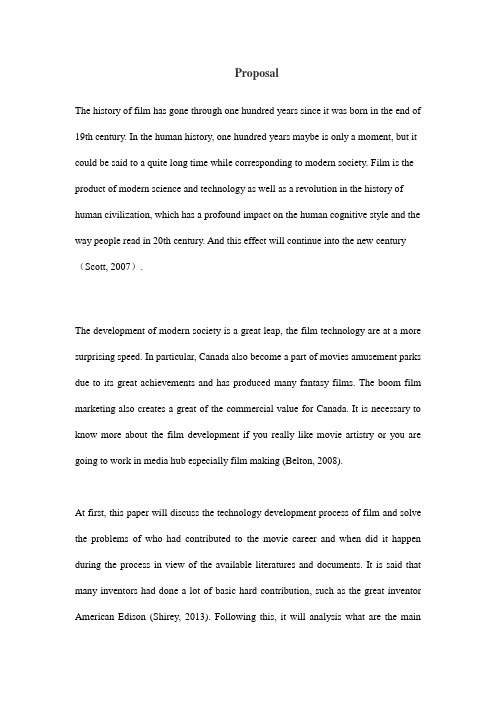
ProposalThe history of film has gone through one hundred years since it was born in the end of 19th century. In the human history, one hundred years maybe is only a moment, but it could be said to a quite long time while corresponding to modern society. Film is the product of modern science and technology as well as a revolution in the history of human civilization, which has a profound impact on the human cognitive style and the way people read in 20th century. And this effect will continue into the new century (Scott, 2007).The development of modern society is a great leap, the film technology are at a more surprising speed. In particular, Canada also become a part of movies amusement parks due to its great achievements and has produced many fantasy films. The boom film marketing also creates a great of the commercial value for Canada. It is necessary to know more about the film development if you really like movie artistry or you are going to work in media hub especially film making (Belton, 2008).At first, this paper will discuss the technology development process of film and solve the problems of who had contributed to the movie career and when did it happen during the process in view of the available literatures and documents. It is said that many inventors had done a lot of basic hard contribution, such as the great inventor American Edison (Shirey, 2013). Following this, it will analysis what are the mainfactors to boost the film career, which develops so fast from silent movies to sound motion picture, black-and-white movies to colorful motions, theaters to digital and so on. For instance, Canada movie academic research had great development around 1940s that aim at strengthening its academic work. In 1941, the Government Bureau began to incorporate with the Film Commission and then successfully resolved film production and distribution problems during the wartime (Frank, 1993). The International Film Festival has been established throughout the Canada like the Vancouver International Film Festival, the Montreal World Film Festival, Ottawa International Animation Film Festival and so on. Finally, it will explore the meanings of film development by comparing its influences with several major technological inventions in human history such as musical instruments, gramophone and stenography. Beside, what have been brought to Canada through the long term of development is also a key in this part.Work CitedScott, A. O. (August 12, 2007). “Two Outlaws, Blasting Holes in the Screen” The New York Times.Belton, John (November 10, 2008). American cinema/American culture McGraw-Hill.p. 420. ISBN 978-0-07-338615-7.Shirey, Paul (April 9, 2013). Cmon Hollywood: Is Hollywood going to start being made in China? . Retrieved 2013-06-14.Frank N. Magill, Ed. (1993), Great Events from History II: Arts and Culture Series volume 3:1937-1954 pp 1159-1163。
电影历史英文
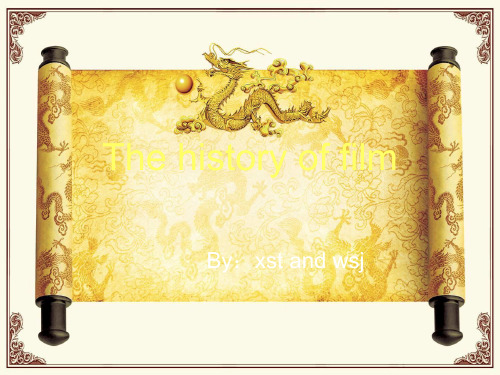
Well, first let's enjoy a video.
Chaplin is the 20th century most of the greatest critical realist film artist . The great contribution of the world's most famous comedy film star Charlie Chaplin, who wrote the history of Hollywood movies and even a glorious chapter in the history of world film
development of Griffith in 1915 with the courage of the artist taken from the world history of the classic silent film "the birth of a nation", in 1916 also shot" intolerance". These two known as the typical base of the film art, the art of starting marks the film, a milestone in the history of American film, is tbut also the history of world film's two classics.
★ 1913-1926 silent film to
爱丽丝梦游仙境电影介绍(英文版)
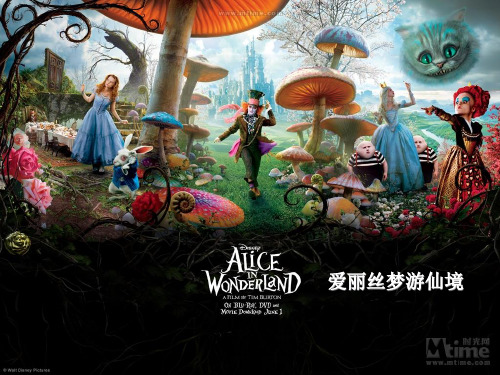
Cheshire Cat(柴郡猫): It is only is a cat with a short tail. It always has smile in its face. It isn’t good but it also not bad.
White Rabbit(兔子):A rabbit always afraid time past. I think it’s funny . March Hare: He is a bit crazy likes to throw the teapot and other tableware. And he also likes to bite his ears and hands. He prefer cooking than doing other things, a strange rabbit.
Alice,
underground messenger of peace, to help the white queen defeat the red queen.(爱丽丝, 地下和平的使者, 帮助白皇后打败 红桃皇后。)
Red queen
,
selfish and brutal leaders, and finally to imprisoned for life and the end!
爱丽丝梦游仙境
plot
• Alice in Wonderland is a 2010 fantasy adventure film directed by Tim BurtonIn the film, Alice is now nineteen years old and accidentally returns to Underland (misheard by Alice and believed to be called Wonderland), a place she visited thirteen years previously. She is told that she is the only one who can slay the Jabberwocky, a dragon-like creature controlled by the Red Queen who terrorizes Underland's inhabitants. • 《爱丽丝梦游仙境》是2010年的奇幻冒险电影导演蒂姆 •BurtonIn电影爱丽丝现在十九岁,意外地回到 Underland(听错了爱丽丝和认为是称为仙境),一个地方她 先前访问了十三年。她被告知她是唯一一个可以杀死无聊, 虎视眈眈的生物控制的红桃皇后统治着Underland的居民。
电影文化简介英文版
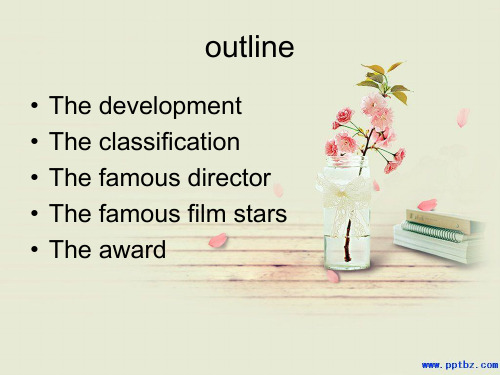
• Anti Japanese War 抗日战争时期 (1937~1945) 八百壮士 Eight Hundred Heroes
swordsmen film 武侠片
Do you know the unique feature of the category of Chinese movie?
swordsmen film
Stars 李小龙 1940年11月27日出生 English name:Bruce Lee
Master work:《唐山大兄》、《精武门》、《猛龙过江》、《龙争虎斗》
outline
• The development • The classification • The famous director • The famous film stars • The award
In early stage
第一次电影放映1896年8月11日,上海徐园内的又一村放映“西洋影戏”, 是中国第一次电影放映。
The award
香港电影金像奖Hong Kong Golden Statue Award 金鸡奖Golden Rooster Award 百花奖Hundred Flowers Award
华表奖 Huabiao award 台湾电影金马奖Golden Horse Prize
Some related expression
成龙,Jackie Chan、 Jacky Chan
1954年4月7日。 He was born in Hong Kong ,and his ancestral home is Shandong. The greater China area film star and international kung fu movie superstar, 成龙的成名作成名作是功
电影历史英文版

Importance of Film History
01
Understanding film history is essential for comprehending the medium's influence on culture and
society.
02
It provides a context for contemporary film production
Studio System
Summary
The Studio System was a system of production that dominated Hollywood from the 1930s to the 1950s.
Detail
Studios were vertically integrated, meaning they controlled not only production but also distribution and exhibition. Stars were under contract to specific studios, and the system was designed to ensure consistent quality and financial success.
1980s)
目录
• Contemporary Cinema (1990s Present) • Conclusion
01
Introduction
Definition of Film History
01
Film history is the study of the development, themes, styles, and techniques of motion pictures.
《电影历史英文版》课件

03
Film genres and styles
Realistic films
Realistic films aim to present a true to life portal of characters and events, avoiding excessive embellishment or memory
The emergence of sound films
Summary
With the incident of sound recording technology, movies gained the ability to include synchronized dialogue and sound effects
The progress of film technology
Summary
Advancements in technology have continuously improved the quality and capabilities of movies, from better cameras and lighting to digital effects and high resolution formats
Early Film Production Techniques
03
Silent movies
movies without sound, releasing on title cards and style to tell the story
Live music
movies were accompanied by a live pianist or organizer to provide the soundtrack
电影发展史-发展期(英文版)

要点二
Description
Early colour processes were often unstable and labour-intensive, but they paved the way for more vibrant and realistic visuals. Techniques such as Technicolor became popular in the 1930s, and their widespread use further enriched the cinematic experience.
Legacy
The growth period laid the foundation for modern cinema, establishing techniques, styles, and practices that are still used in filmmaking today.
Title: The Development of Film: The Growth Period (English Version)
目录
• Introduction • Technical Innovations • Content and Genre Expansion • International Cinema Development • Conclusion
03 Content and Genre Expansion
Epic Films
总结词
Epic Films(史诗电影)是指在电影史上具有重要地位,通常以宏大的历史背景和题材为特点的电影。
详细描述
史诗电影通常以历史事件、战争、传奇故事等为题材,通过展现大规模的场景、复杂的人物关系和深刻的思想内 涵,给观众带来强烈的视觉和情感冲击。这类电影通常需要大量的资金、技术和时间来制作,因此也成为了电影 产业发展的重要标志之一。
英文版电影 歌剧魅影

后来,戏院的投资人劳尔(帕特里克·威尔森 饰)认出克莉丝汀是他的儿时玩伴,两人坠 入爱河。魅影发现后,自觉遭到背叛。随 着魅影愈来愈血腥疯狂,克莉斯汀对他的 感情也逐渐从迷恋转为恐惧、害怕和怜悯 。
半年后,劳尔跟克莉斯汀秘密订婚,魅影 突然现身于歌剧院的化装舞会,强迫歌剧 院演出他亲手谱作的歌剧《唐璜》,并指 名由克莉丝汀担任女主角。
看了几遍《歌剧魅影》,依然非常喜欢。 喜欢魅影,也沉迷与优美的音乐。故事的 结局我也很喜欢,一切都会过去的,等年 老了再回看的爱情或许更是美丽。
The end Thank You
幼年丧父的小克莉丝汀·戴伊在歌剧院接受 舞蹈训练,成为一名芭蕾舞女。同情她的 孤独,魅影假扮音乐天使,隔着墙对她说 话,安慰她幼小的心灵,并教她歌唱的技 巧。就这样九年过去了,年轻貌美的克莉 丝汀(艾米·罗森饰)在魅影的帮助下凭借 美妙的歌喉一夜成名。然而,最初发自于 精神层面的音乐之爱,却逐渐转化成为强 烈的爱情和占有欲。走火入魔的魅影,把 所有妨碍克莉丝汀歌唱事业的人一一除掉 。
电影感悟
魅影不是自卑,是绝望,对人性的绝望。克里斯 汀是他对人间美好的幻想,是他幻想也在等待的 爱。命运让他丧失了一切,遭世人唾弃并耻笑, 是人世的冷漠让他变的无情。他在暗无天日的地 下室多年的付出,使他的世界永远的黑暗。当最 后一个希望的光线也走了,是人都会疯狂的。
他(魅影)发掘她的天赋,赐予她音乐,引领她 成功,为了她,竭尽全心。他以为她就会感激他 ,爱他,永远陪伴他。可是他却发现,她怕他。 是的,她怕他,所以,她并不爱他。
在《唐璜》首演 当晚,歌剧院四 周布满警察,孰 料魅影竟然杀死 男主角,亲身改 扮上场,与克莉 丝汀演对手戏。 在戏演到最高潮 时,克莉丝汀当 众扯下他的面具 ,魅影羞愧心碎 之际动手将克莉 丝汀掳至他的地 下密室……
100经典英文电影

9、 《美国美人》American Beauty 1999年 8.6 这部电影能入选到TOP10有点叫人惊
讶,美国特有的中产阶级影片。
10、 《飞跃疯人院》One Flew Over the Cuckoo's Nest 1975年 8.6 米洛斯·福尔
曼和杰克·尼克尔森两人共同的颠峰,一堂影视表演的必修课。 转贴
由亨利·方达领衔主演,是一部非常精彩的电影。整个故事发生在一间屋子之中
,12个性格各异的人演出了一场智慧、理智与偏见之间的斗争。其中不乏精彩的台词和精
妙的构思。
27、 《光荣之路》Paths of Glory 1957年 8.4
库布里克早期经典,柯克·道格拉斯主演。
这部为科波拉赢得赞誉和金棕榈的影片也因恶劣的票房让他被上了十年才清偿的
高额债务,里面戏份极少的白兰度依然人们关注的焦点。
50、 《热情似火》Some Like It Hot 1959年 8.2
比利·怀尔德导演、玛丽莲·梦露、托尼·柯蒂斯和杰克·莱蒙三人联袂主演的
好程度。扮演拳王拉莫塔的德尼罗不但为学拳击而伤痕累累,还为贴近形象迅速增肥五十
多磅,他的敬业精神至今成为众多演员的楷模。
44、 《善、恶、丑》Il Buono, il brutto, il cattivo 1966年 8.3
一生只有不到10部作品的意大利导演塞尔乔·莱翁内却是意大利西部片的开山鼻
21、 《沉默的羔羊》The Silence of the Lambs 1991年 8.5 当"野牛比尔"从黑
暗中走来,你听到的是羔羊的哭泣,还是自己的心跳?
22、 《风云人物》It's a Wonderful Life 1946年 8.4 弗兰克·卡普拉导演,詹姆
电影院的故事英文版作文
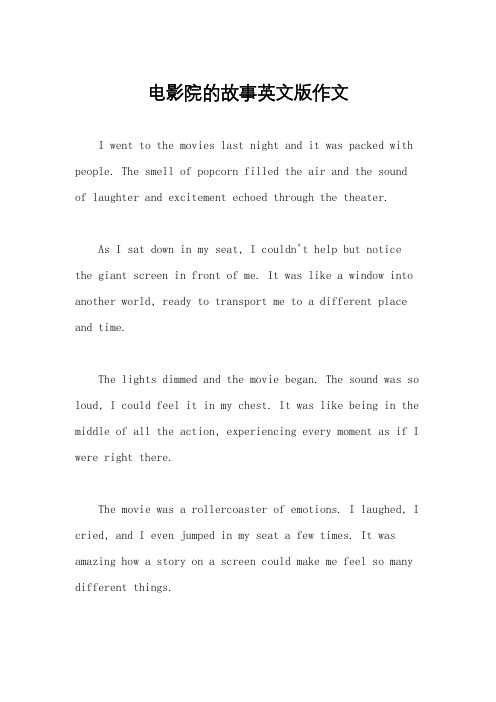
电影院的故事英文版作文I went to the movies last night and it was packed with people. The smell of popcorn filled the air and the sound of laughter and excitement echoed through the theater.As I sat down in my seat, I couldn't help but notice the giant screen in front of me. It was like a window into another world, ready to transport me to a different place and time.The lights dimmed and the movie began. The sound was so loud, I could feel it in my chest. It was like being in the middle of all the action, experiencing every moment as if I were right there.The movie was a rollercoaster of emotions. I laughed, I cried, and I even jumped in my seat a few times. It was amazing how a story on a screen could make me feel so many different things.As the credits rolled and the lights came back on, I felt a sense of satisfaction. The movie had taken me on a journey and I was grateful for the experience.Leaving the theater, I couldn't stop talking about the movie with my friends. We debated the plot, the characters, and our favorite scenes. It was like we were reliving the whole experience all over again.Walking out into the night, I couldn't wait for the next time I could go to the movies. It was a reminder of the power of storytelling and the magic of cinema.。
电影文化简介英文版共31页

16、业余生活要有意义,不要越轨。——华盛顿 17、一个人即使已登上顶峰,也仍要自强不息。——罗素·贝克 18、最大的挑战和突破在于用人,而用人最大的突破在于信任人。——马云 19、自己活着,就是为了使别人过得更美好。——雷锋 20、要掌握书,莫被书掌握;要为生而读,莫为读而生。——布尔沃
END
电影文化简介英文版
36、“不可能”这个字(法语是一个字 ),只 在愚人 的字典 中找得破,不 要嫉妒 要欣赏 ,不要 托延要 积极, 不要心 动要行 动。 38、勤奋,机会,乐观是成功的三要 素。(注 意:传 统观念 认为勤 奋和机 会是成 功的要 素,但 是经过 统计学 和成功 人士的 分析得 出,乐 观是成 功的第 三要素 。
- 1、下载文档前请自行甄别文档内容的完整性,平台不提供额外的编辑、内容补充、找答案等附加服务。
- 2、"仅部分预览"的文档,不可在线预览部分如存在完整性等问题,可反馈申请退款(可完整预览的文档不适用该条件!)。
- 3、如文档侵犯您的权益,请联系客服反馈,我们会尽快为您处理(人工客服工作时间:9:00-18:30)。
By:xst and wsj
3
>> 0 >> 1 >> 2 >> 3 >> 4 >>
ห้องสมุดไป่ตู้ 2
>> 0 >> 1 >> 2 >> 3 >> 4 >>
1
>> 0 >> 1 >> 2 >> 3 >> 4 >>
START
>> 0 >> 1 >> 2 >> 3 >> 4 >>
1896-1912 year, the film quickly from childhood to become an art and 1913-1926 silent film to mature: In the stage of silent films, for the movie made great contributions to the development of Griffith in 1915 with the courage of the artist taken from the world history of the classic silent film "the birth of a nation", in 1916 also shot" intolerance". These two known as the typical base of the film art, the art of starting marks the film, a milestone in the history of American film, is the highest realm of the movie level, but also the history of world film's two classics.
•
David Griffith, the American movie master with his extraordinary talent, the film from the dramatic slave status out, so that the development of a door with music, art, literature, on an equal footing and independent art. He creatively arranging film photography composition and montage, and clever use of various shots and cross use, made movie history appeared to make us all as the acme of perfection of the first peak.
Well, first let's enjoy a video.
Chaplin is the 20th century most of the greatest critical realist film artist . The great contribution of the world's most famous comedy film star Charlie Chaplin, who wrote the history of Hollywood movies and even a glorious chapter in the history of world film 卓别林是20世纪最伟大的批判现实主义电影 艺术家,世界上最著名的喜剧电影明星卓别林 对电影艺术的伟大贡献,写下了好莱坞电影史, 乃至世界电影史上光辉的一页
The movie has a rich history, more than a century of course, which is the glory of the human civilization history. The countries of the movie both in form and technology are continuous development. Also, any times of the philosophy thoughts influence to the creation of the film, in order to reflect the characteristics of the times. Today let us give you a brief introduction of this history.
In a hurry I go, just as I am in a hurry
★ 1913-1926 silent film to
mature
★ 1927-1945 the film as an art
mature
The history of film
The 19 century 30's Invention period:
People put on December 28, 1895, the first time the world film release as movie that was born. The early films, is not out of the newly born traces. But it is in vaudeville and magic art attitude, which make people feel curious.
In recent years, the 3D movies appeared again which sparked the movie's enthusiasm. We have reason to believe that the next movie can make our life more rich and colorful.
Next, let us see the movie’s four development period
★ The 19 century 30's
Invention period
★ 1896-1912 year, the film quickly from childhood to become an art
1927-1945, the film as an art mature:
1927is in the movie history of epochmaking significance in the years. "The jazz singer" video marked the birth of the sound film era, at the same time also witnessed the film to mature period mark. In 1935, Mamoulian produced a world the first a color feature "The flashy world." The invention of the color film, made movies art enter into a new stage of development. Sound and color make the movie closer to nature. Some movies author, in a film using alternating color and black and white, and received a special artistic effect. The appearance of the color film, marked the movie from birth to a perfect mature stage of development. From now on, film art entered a new stage of development.
After the four period, the film art entered the important period of development. The world cinema from the breakthrough innovations to move towards diversification development. The countries all over the world all take various film to attract viewers, which promote the development of the film art.
